The Dental Implants Procedure
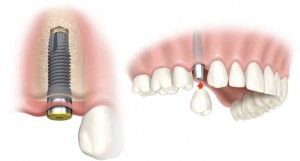
How Dental Implants are Placed?
A dental implant procedure generally involves 2 stages, the placement of the implant in the jawbone and the placement of the tooth restoration on top of it after osseointegration has completed.
The exact procedure followed may be slightly different depending on the individual characteristics of each patient's case. The amount of time required for the treatment may vary significantly, especially if additional treatments such as bone grafting or sinus lift augmentation are necessary to prepare the implantation area.
In this Article:
The Dental Implants Procedure in Brief
The treatment procedure described in this page refers to the most typical case, the placement of a single endosseous root-form implant in two surgical phases.
The first surgery involves the placement of the dental implant (post) in the jawbone, followed by a healing period of three to six months, called osseointegration, in which the titanium screw integrates with the jawbone. After this period, during a second surgery, the dentist exposes the post and places an abutment that will anchor the tooth restoration. Traditional implants are placed using this two-surgery process, although some newer types can be placed in a single step procedure.
The placement of dental implants is an invasive procedure that may make some patients with dental anxiety feel uncomfortable. Dental sedation can help them to be relaxed throughout the procedure. For patients with severe phobias, sedation is the best and most effective choice.
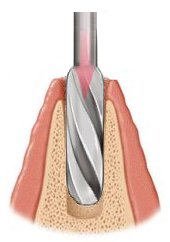
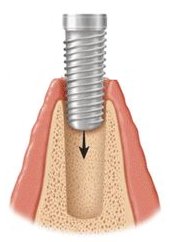

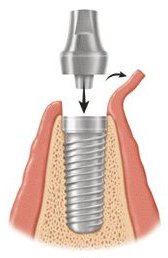
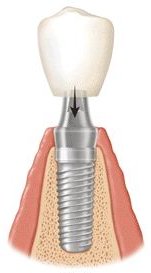
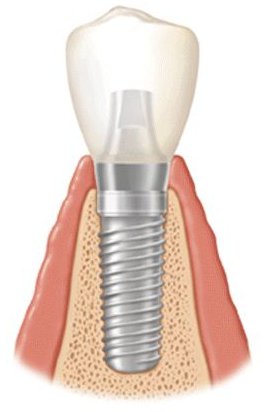
The next sections describe the several phases of the procedure.
1. Implant dentist consultation - Diagnostic phase
If you consider implant treatment, the first thing to do is to find an experienced implants dentist, (prosthodontist, periodontist, oral surgeon or general dentist) with advanced training in these treatments.
The initial dental consultation during the diagnostic phase usually includes:
- Medical and dental history - the dentist will ask for a complete and detailed medical and dental history, a list of medications the patient is taking and finally will ask about habits like smoking, drug/alcohol use or bruxism that could increase the risk of complications and implant failure.
- Oral examination - a thorough oral exam will reveal any dental health problems, tooth decay or gum disease, that have to be treated before starting the procedure.
- X-rays - x-rays provide information about the condition and shape of the jawbone and adjacent teeth roots and help the dentist in designing the proper treatment plan.
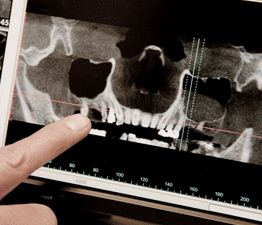 CT-scan - If there is concern about the quantity or quality of the jawbone, the dentist will request a computerized tomography (CT) scan of the mouth that gives a more detailed 3-dimensional image of the jawbone.
A CT scan is recommended in all cases as it can provide a clear view of the location of nerves and sinuses, minimizing the possibility of surgical errors and complications.
CT-scan - If there is concern about the quantity or quality of the jawbone, the dentist will request a computerized tomography (CT) scan of the mouth that gives a more detailed 3-dimensional image of the jawbone.
A CT scan is recommended in all cases as it can provide a clear view of the location of nerves and sinuses, minimizing the possibility of surgical errors and complications.- Teeth impressions - a scale model of the patient's existing teeth will help to determine the best possible size and placement locations for the new implants.
- Treatment planning - after gathering the necessary information, the dentist will determine if the patient is suitable to get an implant and discuss with the patient the available options, possible complications and risks, additional treatment needs and explain the relevant costs.
2. Implantation area preparation
Any problems identified during the diagnostic phase must be addressed to prepare the jaw for the implant placement. One or more of the following treatment may be required:
- Bone Graft - if the x-rays or/and CT scan show that there is not enough healthy bone to support the implant, the only solution is bone grafting (bone augmentation). The patient may have to wait for about 4-12 months until there is sufficient bone build-up before starting the surgery.
- Sinus Augmentation (sinus lift) - if there is not enough jaw bone up to the sinus cavity and the bone height is not enough for the placement of an upper jaw implant, the dentist wll recommend a sinus augmentation (sinus lift) treatment.
- Gum Disease treatment - any gum disease problems must be treated completely before starting the treatment to avoid the risk of implant infection.
- Soft Tissue Graft - treatment of severe gum recession with soft tissue graft is recommended before the dental surgery procedure to provide enough gum tissue for covering the implant post.
- Tooth Extractions - if any other teeth are in very poor health condition, it may be better to be extracted and their replacement with implants to be included in the overall treatment plan.
3. The Dental Implant Surgery
After any necessary pre-treatments are completed, the dentist will prepare the treatment plan and will schedule the appointment for the 1st implant surgery.
1st Surgical phase - The first Dental Implant Surgery
A week before the surgery the dentist will prescribe antibiotics to minimize the risk of infection. The surgical operation is usually performed by an oral surgeon or a periodontist.
- The surgical area is numbed with local anesthesia. If the surgery involves multiple implants the surgeon may offer dental sedation as an option to help make the patient more comfortable.
- The oral surgeon first will make an incision in the gums to expose the bone.

 A small diameter hole is drilled in the jaw area where the implant will be placed and then widened to the appropriate size.
The experience and skill of the dentist is very important during this procedure
to avoid damaging any facial structures such as the nerves, sinuses or adjacent teeth roots.
A small diameter hole is drilled in the jaw area where the implant will be placed and then widened to the appropriate size.
The experience and skill of the dentist is very important during this procedure
to avoid damaging any facial structures such as the nerves, sinuses or adjacent teeth roots.- The implant is screwed into the bone socket. A dental implant is basically a titanium made screw-shaped artificial root that is twisted into the bone to anchor the structure to the jaw.
- An x-ray is taken after placement to ensure proper positioning.
- A protective cap, usually a temporary cover screw, is placed on top of it.
 The gum tissue is repositioned and sutured to cover the screw.
The gum tissue is repositioned and sutured to cover the screw.- Existing restorations, such as bridges or dentures, may be put back in place.
- The dentist will give the patient after-care hygiene and diet instructions, prescriptions for antibiotics and pain medication, and arrange for a follow-up appointment in a few days. (Read more on dental implant surgery aftercare)
- The first surgical phase is completed with the removal of the stitches after 7 to 14 days.
Healing from 1st phase implant surgery - Osseointegration
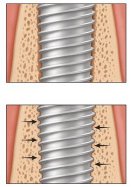 After the implant is placed in the jaw, there is a waiting healing period of several months until it bonds to the bone.
During this period new bone grows around the implant fusing it in the jawbone.
This process, called osseointegration, is the most critical factor for the success of the procedure.
An implant that for any reason can't osseointegrate properly will almost always lead to implant complications.
After the implant is placed in the jaw, there is a waiting healing period of several months until it bonds to the bone.
During this period new bone grows around the implant fusing it in the jawbone.
This process, called osseointegration, is the most critical factor for the success of the procedure.
An implant that for any reason can't osseointegrate properly will almost always lead to implant complications.
The osseointegration period is about 3 months for lower jaw and about 6 months for upper jaw implants. This period is usually longer if the jaw has low bone density. During osseointegration the patient should avoid applying unnecessary pressure on the jawbone. Eating soft foods and avoiding teeth clenching and grinding, in combination with proper daily oral hygiene can help healing.
2nd Surgical phase - The second Dental Implant Surgery
Once the implants have become fused with the surrounding bone, the dentist can proceed to the second surgical phase of the procedure.

- X-rays are taken to confirm proper osseointegration.
- the area is numbed with local anesthesia.
- a small incision is made in the gums exactly over the implant to expose it.
- an abutment (a connector post to anchor the restoration) is screwed on top of it.
- the gums are stitched and left to heal for a few days.
- impressions are taken and send to the dental lab to prepare the restoration.
- a temporary crown is placed on the abutment.
The Final Restoration

 The temporary crown is usually left in place for a few weeks, to allow the gums heal around it just like around natural teeth.
By that time, the permanent crown which is made to match the size, shape and color of the patient's natural teeth will be ready.
The crown can be either cemented or screwed to the abutment.
Once the permanent crown is in place, the replacement implant tooth looks, feels, and functions just like a natural tooth.
The temporary crown is usually left in place for a few weeks, to allow the gums heal around it just like around natural teeth.
By that time, the permanent crown which is made to match the size, shape and color of the patient's natural teeth will be ready.
The crown can be either cemented or screwed to the abutment.
Once the permanent crown is in place, the replacement implant tooth looks, feels, and functions just like a natural tooth.
Dental implant placement procedures have a success rate of over 95% when performed by a qualified and experienced dentist in patients with healthy jawbone.
Follow Up Care
Proper care of implants should not be limited only to the period immediately after the surgery, but it must be a continuous goal. After the procedure is fully completed, the patient must maintain good oral hygiene and visit the dentist regularly in order to ensure the long-term success of the treatment.
next page -> Implant Surgery Aftercare - How to Take Care of Your Dental Implants



